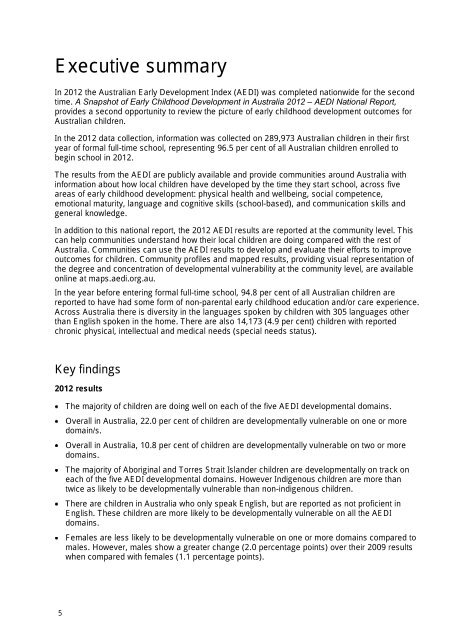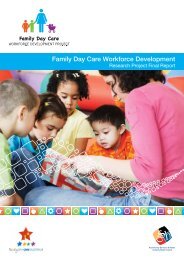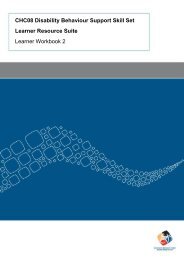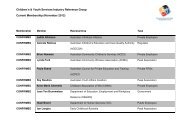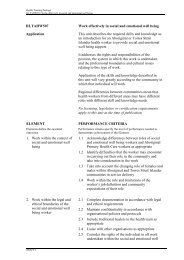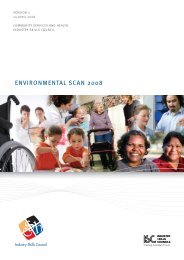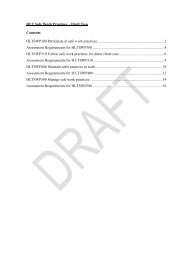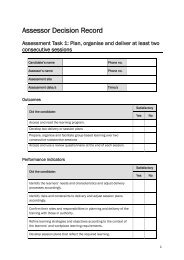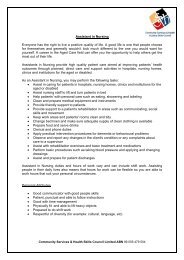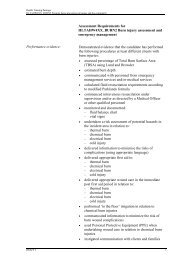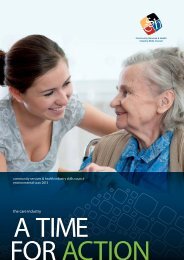A Snapshot of Early Childhood Development in Australia 2012
A Snapshot of Early Childhood Development in Australia 2012
A Snapshot of Early Childhood Development in Australia 2012
You also want an ePaper? Increase the reach of your titles
YUMPU automatically turns print PDFs into web optimized ePapers that Google loves.
Executive summaryIn <strong>2012</strong> the <strong>Australia</strong>n <strong>Early</strong> <strong>Development</strong> Index (AEDI) was completed nationwide for the secondtime. A <strong>Snapshot</strong> <strong>of</strong> <strong>Early</strong> <strong>Childhood</strong> <strong>Development</strong> <strong>in</strong> <strong>Australia</strong> <strong>2012</strong> AEDI National Report,provides a second opportunity to review the picture <strong>of</strong> early childhood development outcomes for<strong>Australia</strong>n children.In the <strong>2012</strong> data collection, <strong>in</strong>formation was collected on 289,973 <strong>Australia</strong>n children <strong>in</strong> their firstyear <strong>of</strong> formal full-time school, represent<strong>in</strong>g 96.5 per cent <strong>of</strong> all <strong>Australia</strong>n children enrolled tobeg<strong>in</strong> school <strong>in</strong> <strong>2012</strong>.The results from the AEDI are publicly available and provide communities around <strong>Australia</strong> with<strong>in</strong>formation about how local children have developed by the time they start school, across fiveareas <strong>of</strong> early childhood development: physical health and wellbe<strong>in</strong>g, social competence,emotional maturity, language and cognitive skills (school-based), and communication skills andgeneral knowledge.In addition to this national report, the <strong>2012</strong> AEDI results are reported at the community level. Thiscan help communities understand how their local children are do<strong>in</strong>g compared with the rest <strong>of</strong><strong>Australia</strong>. Communities can use the AEDI results to develop and evaluate their efforts to improveoutcomes for children. Community pr<strong>of</strong>iles and mapped results, provid<strong>in</strong>g visual representation <strong>of</strong>the degree and concentration <strong>of</strong> developmental vulnerability at the community level, are availableonl<strong>in</strong>e at maps.aedi.org.au.In the year before enter<strong>in</strong>g formal full-time school, 94.8 per cent <strong>of</strong> all <strong>Australia</strong>n children arereported to have had some form <strong>of</strong> non-parental early childhood education and/or care experience.Across <strong>Australia</strong> there is diversity <strong>in</strong> the languages spoken by children with 305 languages otherthan English spoken <strong>in</strong> the home. There are also 14,173 (4.9 per cent) children with reportedchronic physical, <strong>in</strong>tellectual and medical needs (special needs status).Key f<strong>in</strong>d<strong>in</strong>gs<strong>2012</strong> resultsThe majority <strong>of</strong> children are do<strong>in</strong>g well on each <strong>of</strong> the five AEDI developmental doma<strong>in</strong>s.Overall <strong>in</strong> <strong>Australia</strong>, 22.0 per cent <strong>of</strong> children are developmentally vulnerable on one or moredoma<strong>in</strong>/s.Overall <strong>in</strong> <strong>Australia</strong>, 10.8 per cent <strong>of</strong> children are developmentally vulnerable on two or moredoma<strong>in</strong>s.The majority <strong>of</strong> Aborig<strong>in</strong>al and Torres Strait Islander children are developmentally on track oneach <strong>of</strong> the five AEDI developmental doma<strong>in</strong>s. However Indigenous children are more thantwice as likely to be developmentally vulnerable than non-<strong>in</strong>digenous children.There are children <strong>in</strong> <strong>Australia</strong> who only speak English, but are reported as not pr<strong>of</strong>icient <strong>in</strong>English. These children are more likely to be developmentally vulnerable on all the AEDIdoma<strong>in</strong>s.Females are less likely to be developmentally vulnerable on one or more doma<strong>in</strong>s compared tomales. However, males show a greater change (2.0 percentage po<strong>in</strong>ts) over their 2009 resultswhen compared with females (1.1 percentage po<strong>in</strong>ts).5


